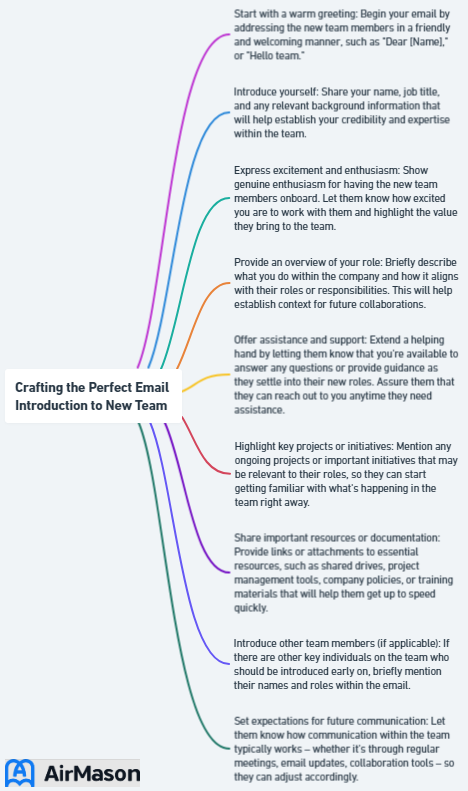
Introducing yourself to a new team can be nerve-wracking, but a well-crafted email introduction to new team can set the stage for successful collaboration and camaraderie. An effective introduction email not only establishes connections but also enhances team dynamics and reflects company culture. This blog post will guide you through the process of crafting the perfect email introduction to new team, ensuring a smooth transition into your new team.
Key Takeaways
- Email introductions are essential for introducing new employees to the workplace and creating positive connections.
- Establishing trust, rapport, unity within an organization and effective collaboration can be achieved by prioritizing connection-building in email introductions.
- Automating introduction emails with HR software allows for a consistent onboarding process that fosters successful working relationships.
The Importance of Email Introductions to New Teams
Email introductions play a crucial role in integrating new employees into the workplace. As a new employee, they help establish connections, enhance team dynamics, and reflect company culture, setting the foundation for a positive and productive work environment.
A thoughtful and engaging introduction email can leave a lasting impression on your new colleagues and foster future collaboration.

Establishing Connections
Creating connections through email introductions is vital for building trust and rapport among new team members. When employees feel connected, they are more likely to collaborate effectively and contribute to the team’s overall success. A well-crafted introduction email can facilitate these connections by providing new employees with an opportunity to share their background and expertise, offering a glimpse into their personality and work style.
Moreover, fostering personal connections can break down barriers between team members from different departments and backgrounds. This not only enhances communication but also encourages a sense of unity and understanding within the organization. Prioritizing connection-building in your email introduction paves the way for improved collaboration and productivity in the long run.
Enhancing Team Dynamics
A thoughtfully composed employee introduction email can significantly improve team dynamics by making new employees feel welcome and valued. When new team members are warmly received, they are more likely to be motivated and engaged in their work. This positive energy can ripple through the entire team, fostering a collaborative and supportive work environment.
Additionally, when you express enthusiasm in your introduction email, it can set a positive tone for your working relationship with your new colleagues. This, in turn, can lead to increased motivation, improved decision-making, and heightened creativity and innovation within the team. Focusing on enhancing team dynamics in your introduction email contributes to a thriving and productive workplace.
Reflecting Company Culture
Email introductions should also reflect the company culture, showcasing the organization’s values and expectations for new team members. Understanding the company culture and adjusting your email’s tone accordingly ensures that your introduction aligns with the existing atmosphere and fosters a sense of belonging among new employees.
Incorporating company culture into your introduction email can also bolster the company’s reputation as a top-notch employer. When new employees receive a warm welcome that reflects the organization’s values, they are more likely to provide positive feedback, which can be immensely beneficial to the company’s employer brand.
Emphasizing company culture in your email introduction helps new team members feel connected and engaged from day one.
Welcome to the Team
We are delighted to extend a warm welcome to you as the newest member of our team. Your arrival marks an exciting new chapter for us, and we are eager to embark on this journey together. “Welcome in the team” reflects not only our enthusiasm for having you on board but also our commitment to fostering a supportive and collaborative work environment. Your unique skills and experiences are a valuable addition to our collective expertise, and we have no doubt that you will make significant contributions to our projects and goals. We encourage you to bring your fresh perspectives and innovative ideas to the table, as they are essential in driving our team’s success. We believe that with your dedication and our shared vision, we will achieve great things together. Once again, welcome in the team!
Crafting an Engaging Subject Line

An engaging subject line is crucial for capturing the attention of your new colleagues and motivating them to read your email introduction. It sets the tone for your email and can be the deciding factor in whether your message gets opened or ignored. To craft an attention-grabbing subject line, consider using a friendly and inviting tone that piques curiosity and encourages recipients to learn more about you.
Some potential subject lines for a new team member introduction email include:
- “Let’s get started!”
- “Meeting my new team”
- “A bit about myself”
- “[Your name] virtual meet and greet”
Taking the time to create a captivating subject line increases the likelihood that your new colleagues will read your email and engage from the start.
Key Components of a New Team Member Introduction Email

A successful professional introduction email should include key components such as personal background, professional experience, and hobbies or interests. Providing this information not only helps your new colleagues get to know you better but also demonstrates your enthusiasm for joining the team and your willingness to contribute.
The following sections will delve deeper into these components, discussing their effective incorporation into your email introduction.
Personal Background and Job Title
Sharing your personal details, such as your personal background and job title, is essential for helping new team members understand their role and place within the organization. Start by introducing yourself and providing your job title, company name, and a concise summary of your background and experience. This information helps your new colleagues situate you within the team and provides context for your responsibilities and expertise.
Including your job title can also establish credibility and authority for your new role. When your colleagues understand your expertise and capabilities, they are more likely to cooperate and communicate effectively with you. Highlighting your personal background and job title in your introduction email facilitates a smooth transition into your new team as you embark on your new job.
Professional Experience and Skills
Including information about your professional experience and skills in your email introduction is a great way to showcase your expertise and how you can contribute to the team. Be sure to provide a brief overview of your previous experience, areas of expertise, and any notable accomplishments relevant to your new role. This information not only demonstrates your competence but also helps your new colleagues understand how your skills can complement the team’s existing strengths.
Sharing your professional experience and skills has several benefits:
- It makes it easier for your new colleagues to identify collaboration opportunities and seek your expertise when needed.
- It can lead to more effective teamwork.
- It can contribute to better overall performance for the entire team.
Showcasing your skills and expertise in your introduction email provides an opportunity to make a strong first impression and lay the groundwork for future collaboration.
Hobbies and Interests
Sharing your hobbies and interests in your introduction email can help humanize you and foster personal connections with your new colleagues. By providing insight into your personality and interests, you make it easier for your new team members to initiate casual conversations and connect with you on a deeper level. This can lead to more harmonious, friendly, and productive interactions within the team.
Some examples of hobbies and interests to include in your introduction email are:
- Sports
- Music
- Reading
- Cooking
- Traveling
- Volunteering
- Creative activities such as painting or photography
Be sure to strike a balance between sharing your interests and maintaining professionalism – it’s important for your new colleagues to see you as both approachable and competent.
Intro Email for New Employee
Sending an effective intro email for new employees is crucial in ensuring a smooth onboarding process. This initial communication sets the tone for their experience within the company and helps them feel welcomed and valued from day one. The intro email for new employees should include essential information such as their start date, location (if applicable), and any documents or forms they need to bring. Additionally, it’s a great opportunity to introduce them to their team members and provide an overview of the company culture and values. Encourage them to reach out with any questions or concerns they may have, fostering an open and supportive environment. Remember, a well-crafted intro email can go a long way in helping your new employee feel confident and excited about joining the team.
Tone and Style: Formal vs. Informal

The appropriate tone and style for your email introduction aligns with the company culture and makes a positive impression on your new colleagues. Factors such as company culture and the recipient’s preferences should be considered when deciding between a formal or informal tone. In general, it’s best to err on the side of formality, especially when introducing yourself to colleagues from other departments or senior management.
However, depending on the company culture and your personal style, adopting a more informal tone may be appropriate. If you choose to use an informal tone, be sure to maintain a professional and respectful demeanor, avoiding overly casual language or slang.
Ultimately, the tone and style of your email introduction should reflect your personality while adhering to the company’s expectations and culture.
Timing and Frequency of Introduction Emails

The timing and frequency of introduction emails can influence how well your message is received by new colleagues. Ideally, it’s best to send your email a few days before your start date, giving your new team members time to read and digest the information. This also allows them the opportunity to reach out with any questions or to schedule a meeting to get to know you better.
When it comes to following up on your introduction email, it’s generally recommended to wait two to three days before sending the first follow-up message. Subsequent follow-up emails can be spaced out by approximately 3 to 4 days. This ensures that you stay engaged without overwhelming your new colleagues with too many emails.
Examples of Effective Email Introductions

To help you craft the perfect self introduction email, here are some examples of effective email introductions for various situations:
- Formal settings: When you need to formally introduce yourself in a formal setting, be sure to demonstrate professionalism and brevity. Start by introducing yourself and your role within the company, followed by a concise summary of your background and experience. Close with a courteous sign-off, such as “Kind regards” or “Sincerely.”
- Informal settings: In an informal setting, aim to be friendly and engaging. Begin by introducing yourself and your role in the company, followed by a brief overview of your hobbies and interests. You may also include a personal anecdote or fun fact about yourself to foster a more relaxed tone. Close with a casual sign-off, such as “Cheers” or “Best wishes.”
- New managers and remote employees: When introducing yourself as a new manager or remote employee, be concise and specific. Start by introducing yourself and your role in the company, followed by a brief overview of your professional experience and capabilities. Offer your assistance and invite your new colleagues to reach out if they have any questions or concerns. Close with a professional but approachable sign-off, such as “Looking forward to working with you” or “Excited to join the team.”
These examples can serve as a starting point for crafting your own unique introduction email that suits your personality and the company culture.
Tips for Following Up on Email Introductions

Following up on your email introduction is an important step in establishing and maintaining open communication with your new team members. Be sure to respond promptly and thoughtfully to any replies you receive, acknowledging the time and effort your new colleagues have taken to engage with you. This demonstrates that you value their input and are committed to fostering positive working relationships.
In addition to responding to replies, consider scheduling a meeting or video call to get to know your new colleagues better. This provides an opportunity for more in-depth conversations and helps build trust and rapport among team members. Proactive follow-up efforts ensure that your introduction email is the beginning of a successful and collaborative working relationship.
Automating and Streamlining Email Introductions

Automating and streamlining your email introductions can save time and ensure consistency in the onboarding process. Many HR software and tools can help you create and send personalized introduction emails with minimal effort, allowing you to focus on more important tasks.
Using these tools enables a quick and efficient introduction to new team members, fostering the building of connections.
For example, some HR software programs, like Personio, offer automated introduction email features as part of their onboarding process. New employees upload a photo and answer a set of pre-determined questions about themselves, and an introduction email is automatically sent to all colleagues on behalf of the CEO. This ensures a consistent and efficient process for welcoming new team members and integrating them into the company culture.
Worksight 2.0: Revolutionizing Workplace Efficiency
Worksight 2.0 marks a significant leap forward in workplace management and efficiency. This innovative platform seamlessly integrates cutting-edge technology with intuitive user interfaces, streamlining operations and enhancing productivity across various industries. With Worksight 2.0, businesses can now harness the power of advanced analytics to gain invaluable insights into their operations, enabling data-driven decision-making like never before. The user-friendly interface allows for easy customization, ensuring that Worksight 2.0 can adapt to the unique needs and workflows of any organization. Moreover, the platform’s robust communication features facilitate real-time collaboration among teams, enabling smoother coordination and quicker problem resolution. In essence, Worksight 2.0 is not just a tool but a transformative solution that empowers businesses to achieve unparalleled levels of efficiency and effectiveness in their day-to-day operations.
Summary
In conclusion, crafting the perfect email introduction is an essential step in establishing connections, enhancing team dynamics, and reflecting company culture. By carefully considering the tone, style, content, and timing of your introduction email, you can make a lasting impression on your new colleagues and set the stage for a successful and collaborative working relationship. Remember, your introduction email is just the beginning – be proactive in following up and maintaining open communication to foster a thriving and productive work environment.
Frequently Asked Questions
How do you introduce yourself in an email to a new team?
My name is [Your Name] and I’m the new [job title] here. I’m excited to be joining the team and am looking forward to getting to know everyone and working together on projects. I hope to make a positive contribution and build strong relationships with the team. Thank you for your consideration.
How do you introduce yourself to a new team professionally?
Introduce myself professionally to my new team by sending a positive message and scheduling a team meeting. Start with an icebreaker or by sharing a fun fact, then discuss my professional background and experience before opening the floor for questions from the team. Finally, create an “about me” page.
How do you introduce a new team member in an email subject line?
Welcome aboard [new employee name]! We’re excited to have them join us as our new [job position] starting from [date], coming to us from [previous company/experience]. We believe that [new employee name] will be a great addition to our team and will bring a wealth of knowledge and experience to
What should I include in my email introduction to my new team members?
I am [name], [job title], with [professional experience] and hobbies/interests. I am excited to be joining the team and look forward to meeting everyone!
How should I choose the tone and style for my email introduction?
When choosing the tone and style for your email introduction, consider the company culture and the recipient’s preferences. Ensure that the content is professional and respectful while remaining aware of the specific atmosphere of the company.